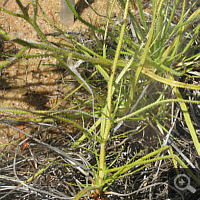Portoguese Sundew (Drosophyllum)
Overview
The Portoguese Sundew is one of the most interesting and spectacular carnivorous plants. The genus Drosophyllum is monotypic. The only one species, namely Drosophyllum lusitanicum is to be found in the coastal regions of Portugal, Southwest Spain and North Morocco, where it grows on stony slopes within thin pinewoods. Especially during summer are these habitats very dry, water supply takes mainly place by nocturnal coastal fog. In winter the habitats are distinct moister.
The plant is perennial and can become relatively large. There are produced up to 25 cm long, small leaves, which arise from the in old age woody main stem. Dead leaves are not dropped – in contrast to the most other plants, but remain hanging on the stem together with the captured insect dead bodies. As botanical speciality exist in the case of the Portoguese Sundew outward rolled up leaves. The slowly developing, young leaves are coiled outward and rolled out during growth. Otherwise such a leaf development is almost only to be found in the case of ferns, normally the leaves are otherwise rolled up inwards.
In early summer large, sulphur-yellow blossoms are produced, from which evolve tough, relatively large, black seeds.
Trap mechanism
The principle trap mechanism was already detailed described on the previous site. The plant is a highly effective insect catcher. On warm days, whole plant emits an intensively, pleasant honey scent, which attracts massy flies, hoverflies and wasps. The pediculated glands produce enzyme containing, exceptionally tough sticky drops, which glint reddishly in the sun. The sticky drops are extremely potent and are even able to hold fast permanently larg flying insects. Also in the case of the pediculated sticky glands Portoguese Sundews show an exception. These arise alongside and from the bottom of the leave and are turned upwards.
Culture and propagation
A longtime culture of Portoguese Sundews is not easy. unfortunately, I have neglected my plant after two years of a successful culture in a winter, in which I was fairly busy, so that it went prompt the way of all flesh. The plant is certainly not suitable for beginners, however, also not such difficult, so that only experts should have a try at the plant. Purchasing of the plant poses already the first challenge. It is extreme root-sensitive. As a consequence, it is quasi not to transplant, but also not ship by post. If you have a friend in your neighbourhood then you are one of the few who must not go the time consuming way of sowing. If you have once attained the rare seeds, it is first necessary to prepare them. I have cautiously whetted the seeds with sandpaper, without demaging them, and subsequently pickled them in water for two days. In the intervening time to sowing you can now merge the soil and fill the pots with it. The Portoguese Sundew is not only root-sensitive, but is also sensitive to waterlogging (what is more or less equivalent to a sudden death). The Portoguese Sundew requires also a well aerated, loose soil. Therefore, I have mixed in equal shares peat with quartz sand and pine bark (you can alternatively use also another rough bark). Because the seedling is later almost not prickable, sowing must happen in the subsequent culture pot, what, at first, admittedly looks quite sillily, when a delicate little plant gets lost in a pot with 15 centimetres in diameter.
In the case of Portoguese Sundews I prefer clay pots, because these allow firtsly a better water budget and secondly a culture in a permanent ebb and flood irrigation system. However, in order that this does not cause a waterlogging, it is first necessary to prepare adequately the pot. First I cover the hole in the bottom with a potsherd, then I the pot to one third with quartz sand, then the remaining two thirds are filled with wetted soil. In future, you can confidently keep the pot in a slight permanent ebb and flood irrigation system, however, only circa one centimetre high. However, never up to the height, in which begins the actual culture-soil. In future, peat-sand-bark-mixture is provided consistently by capillary action of the quartz sand and the clay wall with some moisture, without waterlogging though. Before I water again, I wait until water is exhausted completely and surface of the soil is slightly dried. In such prepared sowing pots I give separately the seeds, per pot one. I press slightly on the seeds but cover them not with soil. Best sowing time is spring. After a few weeks germination starts, then the plant grows quickly. As with most plants, the Portoguese Sundew is during wintertime to cultivate more difficult and so it is advantageous, if the plant has already achieved a certain height.
In summer ideal location is outdoors. Choose a sunny, sheltered from rain location. There it can stay until first frost. In winter quarters should it stand cool, light and dry.

